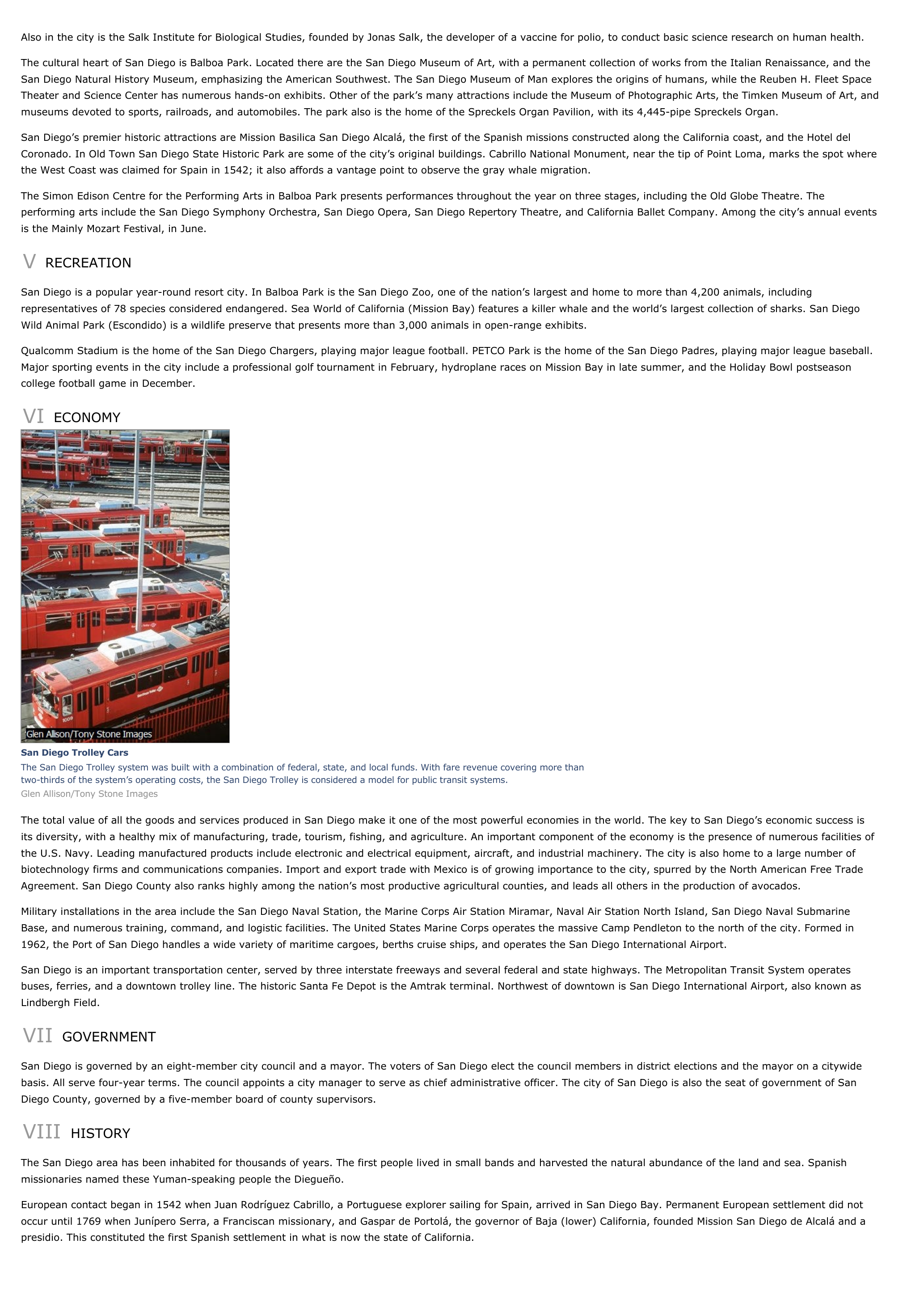San Diego - geography.
Publié le 27/05/2013
Extrait du document
«
Also in the city is the Salk Institute for Biological Studies, founded by Jonas Salk, the developer of a vaccine for polio, to conduct basic science research on human health.
The cultural heart of San Diego is Balboa Park.
Located there are the San Diego Museum of Art, with a permanent collection of works from the Italian Renaissance, and theSan Diego Natural History Museum, emphasizing the American Southwest.
The San Diego Museum of Man explores the origins of humans, while the Reuben H.
Fleet SpaceTheater and Science Center has numerous hands-on exhibits.
Other of the park’s many attractions include the Museum of Photographic Arts, the Timken Museum of Art, andmuseums devoted to sports, railroads, and automobiles.
The park also is the home of the Spreckels Organ Pavilion, with its 4,445-pipe Spreckels Organ.
San Diego’s premier historic attractions are Mission Basilica San Diego Alcalá, the first of the Spanish missions constructed along the California coast, and the Hotel delCoronado.
In Old Town San Diego State Historic Park are some of the city’s original buildings.
Cabrillo National Monument, near the tip of Point Loma, marks the spot wherethe West Coast was claimed for Spain in 1542; it also affords a vantage point to observe the gray whale migration.
The Simon Edison Centre for the Performing Arts in Balboa Park presents performances throughout the year on three stages, including the Old Globe Theatre.
Theperforming arts include the San Diego Symphony Orchestra, San Diego Opera, San Diego Repertory Theatre, and California Ballet Company.
Among the city’s annual eventsis the Mainly Mozart Festival, in June.
V RECREATION
San Diego is a popular year-round resort city.
In Balboa Park is the San Diego Zoo, one of the nation’s largest and home to more than 4,200 animals, includingrepresentatives of 78 species considered endangered.
Sea World of California (Mission Bay) features a killer whale and the world’s largest collection of sharks.
San DiegoWild Animal Park (Escondido) is a wildlife preserve that presents more than 3,000 animals in open-range exhibits.
Qualcomm Stadium is the home of the San Diego Chargers, playing major league football.
PETCO Park is the home of the San Diego Padres, playing major league baseball.Major sporting events in the city include a professional golf tournament in February, hydroplane races on Mission Bay in late summer, and the Holiday Bowl postseasoncollege football game in December.
VI ECONOMY
San Diego Trolley CarsThe San Diego Trolley system was built with a combination of federal, state, and local funds.
With fare revenue covering more thantwo-thirds of the system’s operating costs, the San Diego Trolley is considered a model for public transit systems.Glen Allison/Tony Stone Images
The total value of all the goods and services produced in San Diego make it one of the most powerful economies in the world.
The key to San Diego’s economic success isits diversity, with a healthy mix of manufacturing, trade, tourism, fishing, and agriculture.
An important component of the economy is the presence of numerous facilities ofthe U.S.
Navy.
Leading manufactured products include electronic and electrical equipment, aircraft, and industrial machinery.
The city is also home to a large number ofbiotechnology firms and communications companies.
Import and export trade with Mexico is of growing importance to the city, spurred by the North American Free TradeAgreement.
San Diego County also ranks highly among the nation’s most productive agricultural counties, and leads all others in the production of avocados.
Military installations in the area include the San Diego Naval Station, the Marine Corps Air Station Miramar, Naval Air Station North Island, San Diego Naval SubmarineBase, and numerous training, command, and logistic facilities.
The United States Marine Corps operates the massive Camp Pendleton to the north of the city.
Formed in1962, the Port of San Diego handles a wide variety of maritime cargoes, berths cruise ships, and operates the San Diego International Airport.
San Diego is an important transportation center, served by three interstate freeways and several federal and state highways.
The Metropolitan Transit System operatesbuses, ferries, and a downtown trolley line.
The historic Santa Fe Depot is the Amtrak terminal.
Northwest of downtown is San Diego International Airport, also known asLindbergh Field.
VII GOVERNMENT
San Diego is governed by an eight-member city council and a mayor.
The voters of San Diego elect the council members in district elections and the mayor on a citywidebasis.
All serve four-year terms.
The council appoints a city manager to serve as chief administrative officer.
The city of San Diego is also the seat of government of SanDiego County, governed by a five-member board of county supervisors.
VIII HISTORY
The San Diego area has been inhabited for thousands of years.
The first people lived in small bands and harvested the natural abundance of the land and sea.
Spanishmissionaries named these Yuman-speaking people the Diegueño.
European contact began in 1542 when Juan Rodríguez Cabrillo, a Portuguese explorer sailing for Spain, arrived in San Diego Bay.
Permanent European settlement did notoccur until 1769 when Junípero Serra, a Franciscan missionary, and Gaspar de Portolá, the governor of Baja (lower) California, founded Mission San Diego de Alcalá and apresidio.
This constituted the first Spanish settlement in what is now the state of California..
»
↓↓↓ APERÇU DU DOCUMENT ↓↓↓
Liens utiles
- San Diego - geography.
- San Diego.
- San Francisco - geography.
- San Jose (California) - geography.
- San Antonio (city, Texas) - geography.

































